2 data transmission
1/57
There's no tags or description
Looks like no tags are added yet.
Name | Mastery | Learn | Test | Matching | Spaced |
|---|
No study sessions yet.
58 Terms
DATA TRANSMISSION
the process of sending information from one device to another over a network
how is data sent?
data is broken down into smaller units called “packets”
packets contain…
header
source
destination addresses
sequence number of the packet
how are packets transmitted and reassembled in a network?
they are sent out individually and can take different routes to reach the destination. at the end, the packets are reassembled into the original data
HEADER
contains the destination address, originating address (source address) and packet number so that the correct order is restored once it arrives
PAYLOAD
the contents that need to be sent
TRAILER
has data that indicated the end of the packet and a checksum for the destination to check it transmitted correctly
PACKET SWITCHING
the process of breaking down data into packets and transmitting over a network
process of packet switching
break down data into packets
send the packets through a network
routers control the route taken
reorder packets into the correct order
data is broken down into packets
divided into smaller units each containing a potion of the data and a header with information about the packet
each packet can take a different route
when the packets are now transmitted, they make different routes to reach their destination. each packet are individually moved based on network conditions such as traffic levels, to optimize efficiency and reliability
a router controls the route a packet takes
a router is a device that connects different networks and routes packets to their destination
packets are reordered and reassembled into the original data
put back together
SERIAL TRANSMISSION
bits are sent one signal at a time over a single wire
one bit is sent at the same time
once the bit has been received, the next bit sent
PARALLEL TRANSMISSION
several wires are used so that many bits can be sent at the same time. mainly used within computer systems and components on a circuit board level
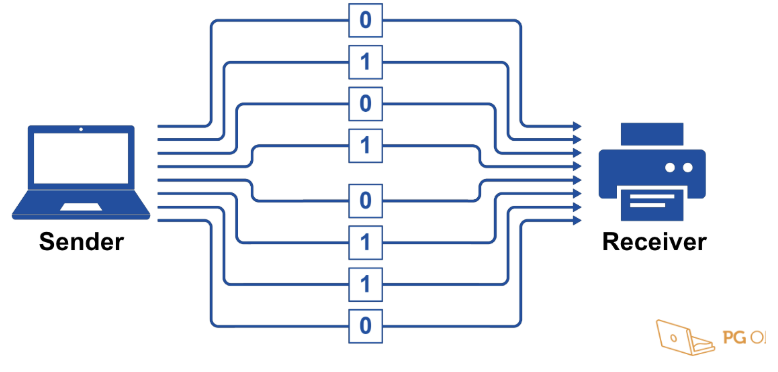
multiplexing
the process of managing various signals between devices, three common methods of doing this are, ‘simplex’, ‘half-duplex’, and ‘duplex’
SIMPLEX
data can only be sent from its source in one direction

HALF-DUPLEX
data can travel in both directions alongside a single connection, but cannot travel (receive and send) simultaneously
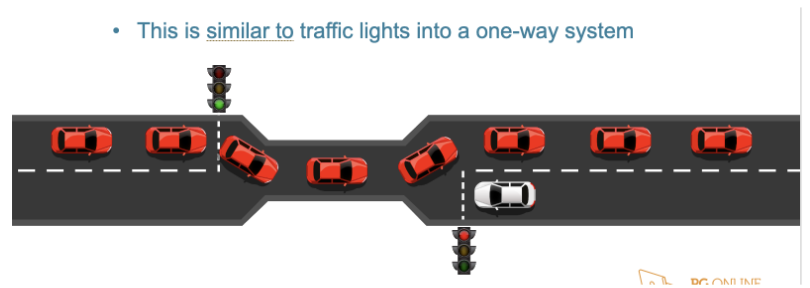
FULL DUPLEX
data can be sent in both directions simultaneously, over separate communication lines
computers between two computers is LAN, where both computers receive and send data at the same time

SERIAL TRANSMISSION advantages
simple hardware and cabling
low cost
low power consumption
suitable for long-distance communication
SERIAL TRANSMISSION disadvantages
slower data transfer rate
limited bandwidth
not suitable for large amounts of data
PARALLEL TRANSMISSION advantages
high data transfer rate
suitable for large amounts of data
more efficient than serial transmission
PARALLEL TRANSMISSION disadvantages
complex hardware and cabling
higher cost
higher power consumption
limited maximum cable length
SIMPLEX TRANSMISSION advantages
simple hardware and cabling
suitable for one-way transmission
no need for a return channel
SIMPLEX TRANSMISSION disadvantages
data can only be transmitted in one direction
limited to simple communication scenarios
not suitable for bidirectional communication
HALF-SIMPLEX TRANSMISSION advantages
data can be transmitted in both directions
suitable for limited bandwidth scenarios
HALF-SIMPLEX TRANSMISSION disadvantages
data can only be transmitted in one direction at a time
not suitable for high-bandwidth communication
more complex than simplex transmission
FULL-SIMPLEX TRANSMISSION advantages
data can be transmitted in both directions simultaneously, over separate communication lines
suitable for high bandwidth communication
more efficient than duplex transmission
FULL-SIMPLEX TRANSMISSION disadvantages
more complex hardware and cabling
higher cost
higher power consumption
ERROR CHECKING
when data is sent from one device or component to another, there is always a chance that the data might become corrupt/damaged during transfer
data integrity
refers to ensuring the data is correct and as it was intended to be
possible transmission errors:
electrical interference
power surges
synchronisation issues
wear and tear on the cable or connectors
transmission errors may cause:
lost data
gained data
changed data
PARITY BITS
2 types; even and odd. when sending a byte of data, one bit is used as a parity bit
EVEN PARITY BIT
the parity bit is set to be 1 or 0 so the total number of 1s transmitted are an even number
ODD PARITY BIT
all 1s must add up to an odd number
using parity for error detection:
if the wrong number of bits are found an error has occurred
it isn’t possible with parity checks to know which bit was incorrectly transmitted
PARITY BLOCK CHECK
in a parity block check, each byte has a parity but whilst an additional parity byte is sent at the end of the block (7 bits, 1 parity bit = 8 bits = 1 byte)
CHECKSUMS
a value that represents the number of bits in a transmission message
run through an algorithm that produces a checksum which it also sends
when the file arrives, the receiving computer generates the checksum and compares it with the checksum that was sent
if the checksums don’t match, the file may have been corrupted or altered during transmission
CHECKSUMS steps
a checksum is created and sent with the file
when received the checksum is again generated
if it doesn’t match the sent checksum, an error has occurred
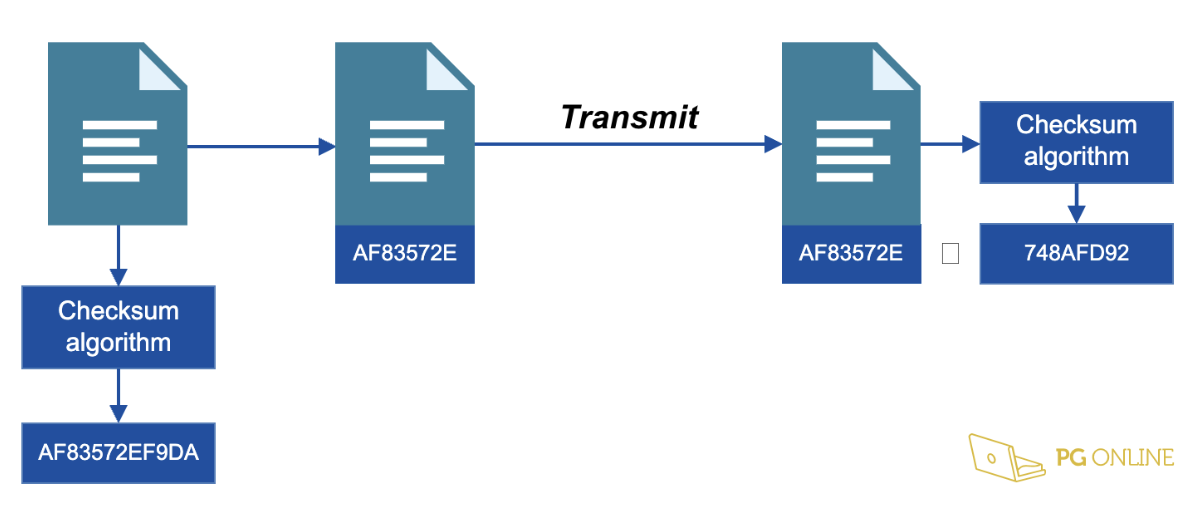
ECHO CHECK
an echo check acts in the same way as an echo from a wall
ECHO CHECK steps
the data is transmitted to the receiver
the same data then echoed back to the transmitter
the transmitter compares the data with the original. if it isn’t the same, the data is transmitted again

CHECK DIGIT
an additional digit the end of a set of other numbers designed to check for mistakes in input or transmission
ISBN
printed books have a unique barcode with an ISBN (International Standard Book Number). contains 10 digits, with the last digit being the check digit
UPC
UPC (Universal Product Code) contains series of bars and spaces of different widths, representing different digits
calculating the check digit:
check digits are calculated by multiplying each number by a weight of 1 or 3 as shown below

describe how an automatic repeat query (ARQ) can be used to establish that data is received without error
the sender first sends a block of data
the receiving computer then sends back an acknowledgement
when the sender receives the acknowledgement, it sends the next block of data
if the acknowledgement is not received after a period of time, a timeout occurs and the data is resent
this process continues until the acknowledgement is received

ARQ flowchart
if the sender does not receive an acknowledgement within a certain time period, known as TIMEOUT, it assumes that the data packet was lost or corrupted during transmission. the sender then retransmits the data packet, continuing until the sender receives a positive acknowledgement from the receiver
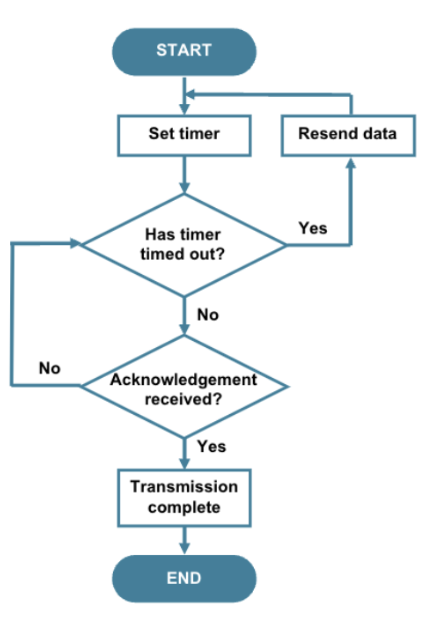
negative acknowledgements
when a data block is correctly received, an acknowledgement is sent
when the receiver detects an error in a data block that has been sent, a negative acknowledgement (NACK) is sent
by sending a NACK, the sender doesn’t need to wait so long in a timeout - it can immediately send the data block again
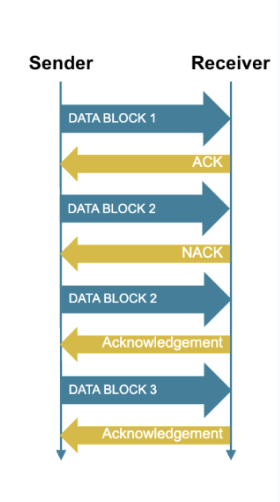
ENCRYPTION
is a process used to secure data during transmission by converting the original data into a coded form that cannot easily be understood by unauthorised users. encryption is used to encode a file or data into something that cannot be read or understood.
why does encryption need to occur?
Confidentiality
Integrity
Authentication
Compliance
problems when encryption is not done
security breaches - data could be intercepted
privacy violations - personal or sensitive information could be exposed
miscommunication - could be misunderstood or misinterpreted
compliance violations
SYMMETRIC ENCRYPTION
Uses a single shared key to both encrypt and decrypt data. A key is shared between the sender and receiver. the receiver uses the key to then decrypt the data

ASSYMETRIC ENCYRPTION
uses a pair of keys, one for encryption (public key) and one for decryption (private key).
the public key is accessible by anyone and uses to encrypt data
the private key is kept secret by the receiver and used to decrypt data
anyone can encrypt the data but only the receiver can decrypt it.
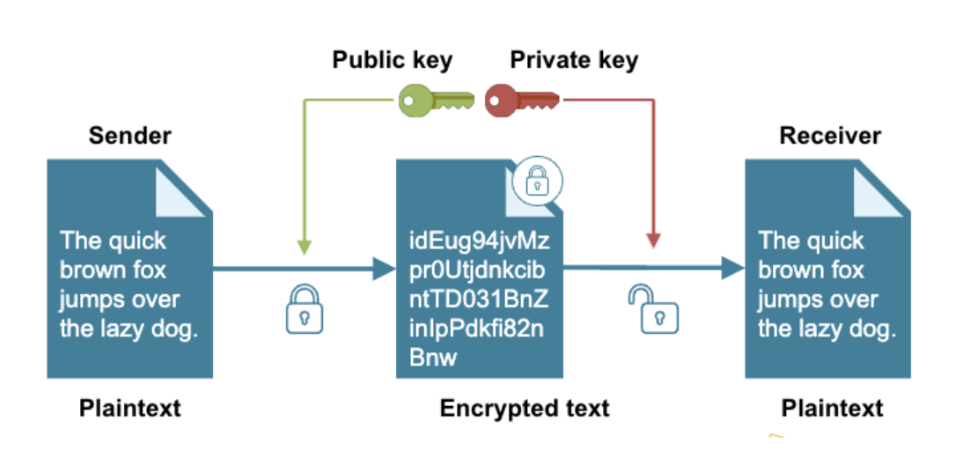
what is USB (Universal Serial Bus)?
USB is a serial cable commonly used to connect external devices (e.g., keyboards, mice, flash drives) to computers, laptops, tablets, and smartphones.
what are the benefits of USB?
✅ USB 1 operates at speeds between 1.5 and 12 Mbps
✅ easier connection compared to older parallel and serial cables
✅ can connect various devices by installing necessary drivers
what are the drawbacks of USB?
❌ USB cables should be ≤5 meters before needing a USB hub
❌ not fast enough for internal devices like CPUs or hard drives
how is USB used to transmit data?
USB transmits data serially, meaning one bit at a time over a single data line. It follows a master-slave architecture, where the host device (e.g., a computer) controls data flow.